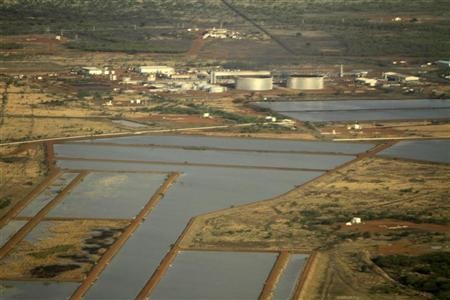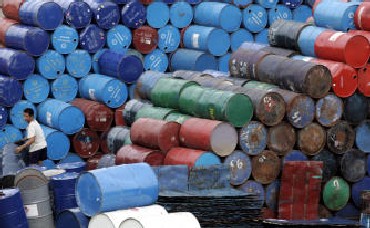Photographs: Akintunde Akinleye/Reuters Jyoti Malhotra in Khartoum
Africa's oil map is on the verge of dramatic transformation with the emergence of the breakaway Republic of South Sudan as the world's newest nation on July 9, but India's ONGC Videsh Ltd (OVL) seems to have successfully managed the geostrategic transition in surprising cooperation with its chief rival, the China National Petroleum Corporation (CNPC).
Across sub-Saharan Africa, daring Indian entrepreneurs are visibly sending the collective adrenalin of several countries soaring through exciting ventures, such as growing rice and roses to both feed and beautify the world, but in each case there also exists a silent rivalry with the world's second most powerful nation, China.
In most of Africa, China is winning the foreign investors game hands down, pumping in money as well as labour to build a network of roads, railway tracks as well as shiny new buildings, while India focuses its limited resources on "capacity building" or partnering local institutions in improving health care, education or the private sector.
...
How Sudan has brought India, China together
Photographs: Reuters
It is only in Sudan, ranked by the UNDP as amongst the poorest countries in the world (141st out of 177), that the drive to exploit its rich natural resources, chiefly hydrocarbons, has brought India and China on the same side.
At stake in the Sudan bonhomie are total oil reserves of 5-6 billion barrels, of which only 400,000 barrels are being produced daily.
But ever since US sanctions kicked into place in 1997 against President Omar al-Bashir's role in the humanitarian tragedies in Darfur and the five-decades-long civil war in southern Sudan, thereby limiting western interest in that country, the field has been left open for China, India and Malaysia to develop Sudan's rich hydrocarbon potential.
All this is about to change when South Sudan formally secedes from the mother country in July, as 90 per cent of the oil fields are geographically located in the new country.
...
How Sudan has brought India, China together
Image: An aerial view of the Heglig oil processing facility in SudanPhotographs: Reuters
But since the port of Bashair on the Red Sea as well as most of the oil infrastructure is located in north Sudan, both sides have had no option but to sheathe their animosity and agree on a 50:50 revenue sharing of the oil's spoils.
"Since oil is so crucial to the economies of the old as well as new Sudan, the leaderships of both countries have assured us that they will honour all the contracts with foreign investors as well as secure production and passage right up to the Red Sea," Pomila Garga, OVL's country director in Sudan, told a group of visiting Indian journalists in Khartoum.
Garga admitted that in the resource-rich Abyei region which straddles the North and South Sudan, which is sometimes touted as another "Kashmir" because of its long-term conflict potential, OVL had a minor stake in the Block 4 oilfield, but promised that this was not a "major concern".
...
How Sudan has brought India, China together
Photographs: Amit Dave/Reuters
Garga admitted that OVL's Sudan gamble had nicely paid off since it bought a 25 per cent stake in 2003 in Greater Nile Petroleum Operating Company (GNPOC), in which CNPC owned a 40 per cent stake, Malaysia's Petronas owned a 30 per cent stake and the remaining five per cent was held by a Sudanese company.
The Sudan acquisition by the Vajpayee government was part of an expanding vision of India's energy security policy, and hard-fought at the time.
By the time the Manmohan Singh-led government came to power in 2004, OVL was not given permission to buy a stake in Nigeria's much sought-after oilfields. No reasons were given, but it was an indication of the pulls and pressures of international power politics on India's energy sector.
...
How Sudan has brought India, China together
Photographs: Kham/Reuters
Unhappily, though, OVL's pioneering efforts have failed to persuade risk-averse Indian investors to follow through in the oil rush.
With most Indian entrepreneurs focused on the doing business with the West, the implied double whammy of US sanctions have had the effect of emptying the Sudanese landscape of large-scale Indian investments, like those found in Ethiopia and Tanzania.
As a result, OVL has had to depend largely on Chinese companies for services such as seismic surveys, renting oil rigs for drilling, spare parts, etc.
"The Chinese are in Sudan in a big way. They are so disciplined and hard-working, it is amazing to see them work. They also respond very fast to any request for material or rigs. We would like to work with Indian companies, but they are very slow in responding," Garga added.
Her senior colleagues murmured assent. All of them agreed that OVL had never faced any problems from Chinese companies in Sudan.
...
How Sudan has brought India, China together
Photographs: Akintunde Akinleye/Reuters
Asked what made the Chinese different from Indian companies, Garga said the Chinese were "so focused" about what they wanted, they would stop at nothing at invoking their political, corporate and business leaderships to influence the Sudanese government to allow them to expand their role in the hydrocarbon sector.
In contrast, Indian companies wholly swallowed Sudan's terrible reputation in the western media of being an unstable economy run on the whims of a dictator, OVL executives said. "India has to decide whether it wants to make money or be worried about Sudan's lack of democratic credentials," they added.
China is believed to have invested as much as $20 billion in Sudan's oil industry, making it Beijing's largest investment in Africa.
...
How Sudan has brought India, China together
Besides investment in oil production, its "resources for infrastructure" policy includes the building of several refineries as well as a pipeline to the Red Sea for the transportation of oil whose destination is, largely China.
But with the oil map of Africa on the verge of being transformed, western companies are already making a beeline for the oilfields of South Sudan.
Rumour is that the US has promised to lift sanctions against the North in exchange for allowing the South to secede, and that talks with Switzerland, Germany and Turkey for investment in the hydrocarbon sector had begun.
In contrast, OVL's modest vision of an oil producer in Sudan echoes the lack of a coherent strategic policy in New Delhi's corridors of power.
...
How Sudan has brought India, China together
Small investors, especially those whose families have lived in Sudan for over a hundred years, keep the flag flying with trading in pharmaceuticals, motor spare parts, etc, but much of their imports are also sourced from China.
EXIM bank has recently unveiled a $200-million lending to Africa's banks, but in countries like Sudan, which are run by a thin, autocratic elite, Beijing's policy of asking-no-questions has served China very well.
Khalid Musa Dafalla, the spokesperson of the Sudan's ministry of foreign affairs, prefacing his comments by saying this was his personal view, pointed out that India's imposition of certain conditionalities, for example, on carbon-emitting technologies had persuaded Khartoum to lean in favour of the Chinese.










article